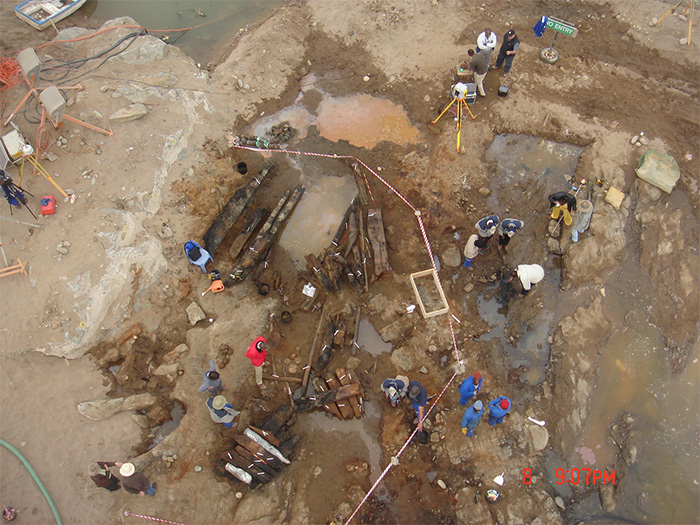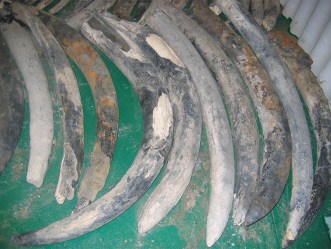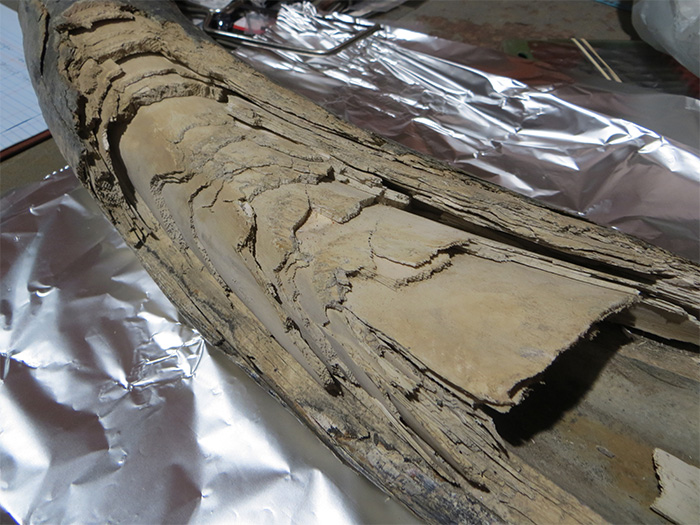A cargo of ancient African ivory recovered from a 16th-century shipwreck is shedding light on early trade networks and historical elephant populations.
 The wreck of the Bom Jesus and its surviving cargo were discovered on the coast of Namibia in 2008. [Image: Ashley Coutu]
The wreck of the Bom Jesus and its surviving cargo were discovered on the coast of Namibia in 2008. [Image: Ashley Coutu]
On 7 March 1533, the Bom Jesus set sail from Lisbon. It was part of a fleet of Portuguese carracks, laden with naval equipment and precious goods for trade and exchange, bound for western India where they would pick up valuable pepper and spices. But just four months into the 15-month journey, the fleet was caught in a violent storm as it rounded the southern tip of Africa. The Bom Jesus was blown off course and disappeared, seemingly forever.
Its destiny remained unknown until 2008, when workers mining for diamonds on the coast of Namibia discovered the remains of a ship in a cofferdam. Excavations revealed that much of the ship’s structure and over 40 tons of its cargo survived intact, well-preserved for almost 500 years by the cold waters caused by the Benguela ocean current. Among the artefacts recovered were thousands of copper ingots and gold and silver coins, which proved to be key to identifying the ship as the Bom Jesus. But another discovery, of perhaps even greater significance, was the presence of more than 100 elephant tusks, the largest archaeological cargo of African elephant ivory ever found.
 More than 100 elephant tusks were recovered from the Bom Jesus, offering a remarkable insight into global ivory trade in the 16th century. [Image: National Museum of Namibia]
More than 100 elephant tusks were recovered from the Bom Jesus, offering a remarkable insight into global ivory trade in the 16th century. [Image: National Museum of Namibia]
The ivory industry
Analysis of these tusks, recently published in Current Biology (https://doi.org/10.1016/j.cub.2020.10.086), has revealed important information about the Bom Jesus and the early global trade networks of which it was a part, as well as providing valuable data about historic elephant populations.
A combination of DNA and isotopic analysis was used to determine that the tusks on the Bom Jesus would have come from at least 17 different herds of forest elephants living in West Africa at the time. The ivory of West African forest elephants (Loxodonta cyclotis) was preferred to that of savanna elephants (Loxodonta africana) because the hard, straight, and slender nature of forest elephant tusks made them better suited for carving.
Analysis of the ivory on board the Bom Jesus has revealed a wealth of information about the elephants they came from and the networks involved in their supply. [Images: Ashley Coutu; Judith Sealy]
Both raw and carved ivory is known to have been exported from the Atlantic coast of Africa to Portugal from the mid-15th century and played a significant role in the global maritime trade routes developing in the 16th century. It was an extremely valuable commodity, used to make a variety of decorative items, religious objects, functional pieces, and jewellery, and as such was one of the key materials traded from Africa to Europe, the Middle East, and Asia. Despite this, it is rare for finds of large numbers of tusks from this period to be so well-preserved.
The tusks on the Bom Jesus vary in size, ranging in weight from 2kg to 33kg, and appear to have come from male, female, young, and old elephants, suggesting that they were hunted or scavenged indiscriminately. The fact that at least 17 herds with distinct family lineages are represented indicates that many different communities must have been involved in the supply of the ivory and its transport along internal trade networks to the coast for export.
All 17 of the herds identified were traced to locations in West Africa, where regional ivory trading networks are known to have existed for centuries before the sailing of the Bom Jesus. Although archaeological sites with signs of hunting and processing elephants for ivory are scarce, there is substantial evidence for the wide variety of items, such as pins, bangles, and musical instruments, that communities in this area were creating out of ivory, as well as the intricately carved objects like salt cellars, spoons, olifants (horns), and sculptures that were produced for export as part of gift exchanges and trade between Portuguese and African kingdoms.
A variety of expertly carved items, like these salt cellars, were created in West Africa and exported to Portugal in the 15th and 16th century. [Images: Pitt Rivers Museum, University of Oxford; Metropolitan Museum of Art]
Herds and habitats
As well as demonstrating its prominence in early global trade networks, the large quantity of ivory discovered on the Bom Jesus is significant because of the information it provides about elephant populations in the past.
Of the 17 distinct lineages represented in the 16th-century cargo, only four are still known in modern West African elephant populations. The rest have all been lost, largely due to centuries of hunting for ivory. The genetic information recovered from the Bom Jesus tusks provides important data relating to these lost herds, and will be extremely helpful in the future study and conservation of forest elephants in Africa.
The study also revealed something surprising about the distribution of these 16th-century elephant populations. Isotopic analysis of the tusks indicates that the elephants were living in savanna and mixed habitats rather than the deep tropical rainforests where forest elephants are expected to be found. Some modern forest elephants in West Africa do live outside tropical rainforests, but it was previously assumed that this was a result of the overhunting of savanna elephants in the 19th and 20th centuries. This new information indicates that West African forest elephants were using savanna habitats as far back as the 16th century, well before the more recent widespread disruption of these ecosystems.
This recent research is just the latest example of the many ways in which the Bom Jesus, the oldest known shipwreck in southern Africa, offers a unique opportunity to improve our understanding of the formative stages of the global trade routes that shaped the world in the centuries that followed. Analysis of the elephant tusks on board has revealed valuable information about the West African networks that played a central role in the acquisition and circulation of ivory as part of these routes, and has also provided an insight into historical elephant populations, which is hugely important in filling in the gaps in our knowledge created by the very trade that led to the existence of this remarkable find.
This article appeared in issue 106 of Current World Archaeology. Click here for more information about subscribing to the magazine.



